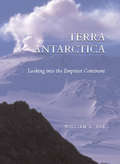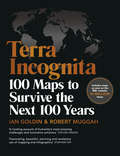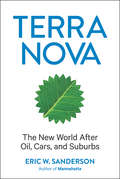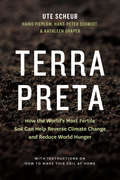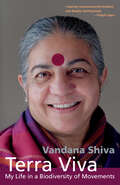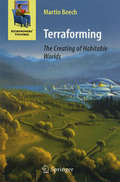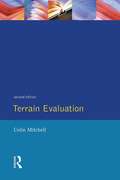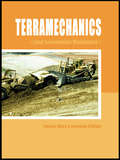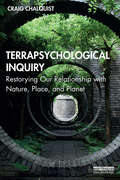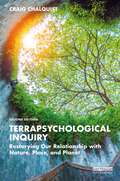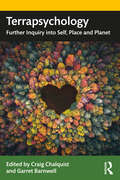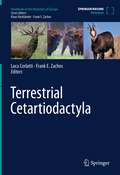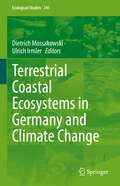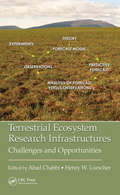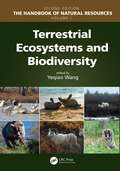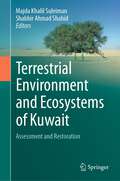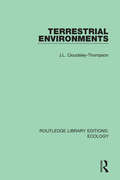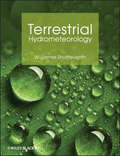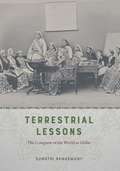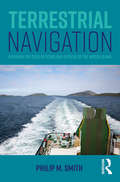- Table View
- List View
Terra Antarctica
by William FoxHow does the human mind transform space into place, or land into landscape? For more than three decades, William L. Fox has looked at empty landscapes and the role of the arts to investigate the way humans make sense of space. In Terra Antarctica, Fox continues this line of inquiry as he travels to the Antarctic, the "largest and most extreme desert on earth." This contemporary travel narrative interweaves artistic, cartographic, and scientific images with anecdotes from the author's three-month journey in the Antarctic to create an absorbing and readable narrative of the remote continent. Through its images, history, and firsthand experiences-snowmobile trips through whiteouts and his icy solo hikes past the edge of the mapped world-Fox brings to life a place that few have seen and offers us a look into both the nature of landscape and ourselves.
Terra Antarctica
by William FoxHow does the human mind transform space into place, or land into landscape? For more than three decades, William L. Fox has looked at empty landscapes and the role of the arts to investigate the way humans make sense of space. In Terra Antarctica, Fox continues this line of inquiry as he travels to the Antarctic, the "largest and most extreme desert on earth." This contemporary travel narrative interweaves artistic, cartographic, and scientific images with anecdotes from the author's three-month journey in the Antarctic to create an absorbing and readable narrative of the remote continent. Through its images, history, and firsthand experiences-snowmobile trips through whiteouts and his icy solo hikes past the edge of the mapped world-Fox brings to life a place that few have seen and offers us a look into both the nature of landscape and ourselves.
Terra Incognita: 100 Maps to Survive the Next 100 Years
by Ian Goldin Robert Muggah'Amazing. It would be my desert island choice' Martin Rees'Fascinating, beautiful, alarming and revelatory use of mapping and infographics' Stephen Fry on EarthTime maps'An indispensable read' Arianna Huffington From the global impact of the Coronavirus to exploring the vast spread of the Australian bushfires, join authors Ian Goldin and Robert Muggah as they trace the ways in which our world has changed and the ways in which it will continue to change over the next hundred years. Map-making is an ancient impulse. From the moment homo sapiens learnt to communicate we have used them to make sense of our surroundings. But as Albert Einstein once said, 'you can't use old maps to explore a new world.' And now, when the world is changing faster than ever before, our old maps are no longer fit for purpose.Welcome to Terra Incognita. Based on decades of research, and combining mesmerising, state-of-the-art satellite maps with enlightening and passionately argued analysis, Ian and Robert chart humanity's impact on the planet, and the ways in which we can make a real impact to save it, and to thrive as a species.Learn about: fires in the arctic; the impact of sea level rise on cities around the world; the truth about immigration - and why fears in the West are a myth; the counter-intuitive future of population rise; the miracles of health and education that are waiting around the corner, and the reality about inequality, and how we end it. The book traces the paths of peoples, cities, wars, climates and technologies, all on a global scale. Full of facts that will confound you, inform you, and ultimately empower you, Terra Incognita guides readers to a new place of understanding, rather than to a physical location.
Terra Nova: The New World After Oil, Cars, and Suburbs
by Eric W. SandersonA look at what the American lifestyle has done to the environment—and how to move toward a better future. In the last century, three powerful forces—oil, cars, and suburbs—buoyed the American dream. Yet now, the quality of life in the United States is declining due to these same three forces. Our dependence on oil is a root cause of wars, recessions, and natural disasters. Cars consume an outsize share of our incomes and force us to squander time in traffic. Meanwhile, expensive, spread-out suburbs devour farmland—and in a vicious cycle, further entrench our reliance on cars and oil. In Terra Nova, conservation ecologist Eric W. Sanderson—the national bestselling author of Mannahatta—offers concrete steps toward a solution. He delves into natural history, architecture, chemistry, and politics, to show how the American relationship to nature has shaped our past, and how it can affect our future. Illustrated throughout with maps, charts, and infographics, Terra Nova demonstrates that it is indeed possible to achieve a better world. &“Sanderson commendably outlines &‘a new way of life . . . designed to sustain American prosperity, health, and freedom for generations to come.&’&” —Publishers Weekly
Terra Preta: How the World's Most Fertile Soil Can Help Reverse Climate Change and Reduce World Hunger
by Tim Flannery Hans-Peter Schmidt Kathleen Draper Haiko Pieplow Ute ScheubTerra preta is the Portuguese name of a type of soil which is thought to have almost miraculous properties. The newspapers are flooded with reports about "black gold," scientists believe that two of the greatest problems facing the world - climate change and the hunger crisis - can be solved by it. The beauty of it is that everyone can do something about it because since 2005 the secret of producing this black soil has been revealed - and it is a secret that seemed to have been lost forever with the downfall of the once thriving Indian culture of the Amazon basin. The recipe is astonishingly simple as all you need are kitchen or garden wastes, charcoal and earthworms, so it can be produced on every balcony or on the smallest of garden plots.The trio of authors Scheub, Pieplow and Schmidt, set off on a treasure hunt and condensed all the knowledge about the world's most fertile soil into a convenient guidebook. In addition to a sound instruction manual on producing terra preta and organic charcoal (biochar), the handbook covers fundamental principles from climate farming to closed-loop economy. It makes a passionate plea against synthetic fertilizers and genetic technology and offers indispensable advice to all those who feel strongly about healthy food.
Terra Viva: My Life in a Biodiversity of Movements
by Vandana Shiva*2023 Nautilus Book Award Gold Medal Winner: Heroic Journeys&“All of us who care about the future of Planet Earth must be grateful to Vandana Shiva.&”—Jane Goodall, UN Messenger of PeaceA powerful new memoir published to coincide with Vandana Shiva&’s 70th birthday.Vandana Shiva has been described in many ways: the &“Gandhi of Grain,&” &“a rock star&” in the battle against GMOs, and &“the most powerful voice&” for people of the developing world. For over four decades she has vociferously advocated for diversity, indigenous knowledge, localization, and real democracy; she has been at the forefront of seed saving, food sovereignty, and connecting the dots between the destruction of nature, the polarization of societies, and indiscriminate corporate greed.In Terra Viva, Dr. Shiva shares her most memorable campaigns, alongside some of the world&’s most celebrated activists and environmentalists, all working toward a livable planet and healthier democracies. For the very first time, she also recounts the stories of her childhood in post-partition India—the influence of the Himalayan forests she roamed; her parents, who saw no difference in the education of boys and girls at a time when this was not the norm; and the Chipko movement, whose women were &“the real custodians of biodiversity-related knowledge.&” Throughout, Shiva&’s pursuit of a unique intellectual path marrying quantum physics with science, technology, and environmental policy will captivate the reader.Terra Viva is a celebration of a remarkable life and a clear-eyed assessment of the challenges we face moving forward—including those revealed by the COVID crisis, the privatization of biotechnology, and the commodification of our biological and natural resources.&“One of the world&’s most prominent radical scientists.&”—The Guardian
Terraforming: The Creating of Habitable Worlds
by Martin BeechThis book proposes a sound and realistic exploration on the topic of terraforming. Often used as the narrative premise in science fiction novels, terraforming is the process by which an uninhabitable planet might be converted into one capable of supporting life. This book presents what is physically possible today and hints what might conceivably be put into practice in the next several hundred years. The author works within the realms of current technology and known physics, although speculation on future advancements inevitably enters the discussion. Introductory chapters establish why terraforming will be of great benefit to human kind, and also put in place the basic physical arguments necessary to the terraforming process. The following parts look at various proposals that have been made for terraforming the planets Mars and Venus. The book concludes with a glimpse to the much deeper future when humankind will explore and colonize the outer solar system and possibly the newly discovered exoplanets.
Terrain Evaluation
by Colin W. MitchellWritten from the point of view of the earth scientist, this book acts as an introduction to terrain evaluation. The emphasis throughout is on the physical rather than the economic, social or legal aspects of the subject, and topics covered include remote sensing and data processing technologies.
Terramechanics: Land Locomotion Mechanics
by T. Muro J. O'BrienTerramechanics is the broad study of terrain-vehicle systems. In this book, all physical processes associated with the static and dynamic interplay between powered and tooled wheeled or tracked vehicles with natural and man-made surfaces are analysed and mathematically modelled.The focus of the book is the technical problem of predicting the p
Terrapsychological Inquiry: Restorying Our Relationship with Nature, Place, and Planet
by Craig ChalquistTerrapsychological Inquiry is a qualitative research methodology seeking a form of inquiry that takes seriously our intense inner responses to the state of the natural world. Terrapsychology is a theory and practice approach that studies, from the standpoint of lived experience, how the world gets into the heart. Oceans and skies, trees and hills, rivers and soils, and even built things like houses, cities, ports, and planes: How do they show up for us inwardly? How do our moods, feelings, and dreams reflect what happens in the world? Terrapsychological Inquiry evolved over a decade of experimentation by graduate students, instructors, workshop leaders and presenters, and other embodied creatives to offer a truly Earth-honoring mode of story-based qualitative inquiry, one that changes all involved from passive spectators of the doings of the world into active, sensitive participants. Learn how to use this methodology of reenchantment in a variety of settings inside and outside academia, and by doing so reenter an animate world. Written in an engaging and accessible style, this introduction to a new research methodology will be of great interest to students and scholars of environmental psychology, ecotherapy, and environment and sustainability studies more generally.
Terrapsychological Inquiry: Restorying Our Relationship with Nature, Place, and Planet
by Craig ChalquistTerrapsychological Inquiry is a path of storied, imaginative research that takes seriously our intense inner responses to the state of the natural world. This place-rooted approach studies, from the standpoint of lived experience, how the world gets into the heart. Oceans and skies, trees and hills, rivers and soils, and even built things like houses, cities, ports, and planes: How do they show up for us inwardly? How do our moods, feelings, and dreams reflect what happens in the world? Terrapsychological Inquiry evolved over a decade of exploration by graduate students, instructors, ceremonialists, workshop leaders and presenters, and other practitioners of embodied creativity to offer an Earth-honoring mode of storied qualitative inquiry, one that transforms all involved from passive spectators of the doings of the world into active, sensitive participants. Learn how to use this methodology of earthly reenchantment in a variety of settings inside and outside academia and by doing so reenter an animate world. This new edition has been revised throughout and offers fresh insights into how Terrapsychological Inquiry, a field with roots in depth psychology, ecopsychology, and Hermetic philosophy, can also be used as an ecospiritual path. Thoroughly updated with a new chapter and added discussion questions and exercises at the end of each chapter, this introduction to an evolving research methodology will be of great interest to students and scholars of environmental psychology, ecotherapy, and environment and sustainability studies more generally.
Terrapsychology: Further Inquiry into Self, Place and Planet
by Craig Chalquist Garret BarnwellReflecting on and exploring the connection between the environments in which we live and our moods, motivations and dreams, this insightful volume takes the growing field of terrapsychology into new and exciting directions. This book draws together a group of contemporary voices in terrapsychology to explore lived topics, such as ecotransference encountered with sacred place, alternative mapping and expressions of solidarities with sacred sites, place dreaming, locianalysis, trans-species encounters, deep genealogy, terraplomacy and Hermeticism. The chapters focus on praxis, demonstrating how each author’s relationship with the more-than-human world has been reenchanted, revealing, remembering and co-creating relationships and community for life to flourish. Co-edited by Craig Chalquist and Garret Barnwell this collection will interest scholars, students and practitioners across a range of fields, including analytical psychology, environment psychology, and cultural anthropology.
Terrapsychology: Further Inquiry into Self, Place and Planet
by Craig Chalquist Garret Barnwell- The place of nature and environment is increasingly recognized in therapeutic theory and practice. - Co-edited by the originator of the theory of Terrapsychology. - Builds on his successful 2020 title, Terrapsychological Inquiry, which we also published.
Terrestrial Biosphere-Atmosphere Fluxes
by Russell Monson Dennis BaldocchiFluxes of trace gases, water and energy - the 'breathing of the biosphere' - are controlled by a large number of interacting physical, chemical, biological and ecological processes. In this interdisciplinary book, the authors provide the tools to understand and quantitatively analyse fluxes of energy, organic compounds such as terpenes, and trace gases including carbon dioxide, water vapour and methane. It first introduces the fundamental principles affecting the supply and demand for trace gas exchange at the leaf and soil scales: thermodynamics, diffusion, turbulence and physiology. It then builds on these principles to model the exchange of water, carbon dioxide, terpenes and stable isotopes at the ecosystem scale. Detailed mathematical derivations of commonly used relations in biosphere-atmosphere interactions are provided for reference in appendices. An accessible introduction for graduate students and a key resource for researchers in related fields, such as atmospheric science, hydrology, meteorology, climate science, biogeochemistry and ecosystem ecology.
Terrestrial Cetartiodactyla (Handbook of the Mammals of Europe)
by Frank E. Zachos Luca CorlattiThis volume provides comprehensive overviews of each terrestrial cetartiodactyl species’ biology including palaeontology, physiology, genetics, reproduction and development, ecology, habitat and diet. Their economic significance and management, as well as future challenges for research and conservation are also addressed. Each chapter includes a distribution map, a photograph of the animal and key literature. This authoritative volume of the Handbook of the Mammals of Europe is a timely and detailed compilation of all European terrestrial cetartiodactyls and will appeal to academics and students in mammal research, as well as to professionals dealing with mammal management, including control, use and conservation.
Terrestrial Coastal Ecosystems in Germany and Climate Change (Ecological Studies #245)
by Ulrich Irmler Dietrich MossakowskiClimate change is one of the most severe dangers for mankind worldwide. Beside the temperature increase, the sea level will rise and flood wide coastal areas, which is already remarkable today. The effects will be dramatic, in particular, at coasts with low elevation gradients such as at the German coasts of the North and Baltic Sea. The impact will be not only severe for coastal people, but still more for the unique coastal ecosystems, which harbors many plant and animal species that are already endangered today.This book focuses on the coastal terrestrial ecosystems of the German North and Baltic Sea. It describes the reactions of plants and animals (i.e. spiders, carabid beetles, bees and nematodes) on the future temperature and sea level increase. The combination of field and experimental studies is unique for Europe and for many parts of the world. It not only studies the actual elevation gradients and the climatic and saline gradients from West to East, but also the historical changes to document processes at coastal ecosystems that were already passed. In contrast to many books that studied the marine processes with similar backgrounds, this book concerns the terrestrial coastal ecosystems that were overall rarely studied and, in particular, never studied under this specific viewpoint.
Terrestrial Ecosystem Ecology
by Göran I. Ågren Folke O. AnderssonHuman activities impact the environment and modify the cycles of important elements such as carbon and nitrogen from local to global scales. In order to maintain long-term and sustainable use of the world's natural resources it is important that we understand how and why ecosystems respond to such changes. This book explains the structure and functioning of terrestrial ecosystems, using examples ranging from the Arctic to the tropics to demonstrate how they react under differing conditions. This knowledge is developed into a set of principles that can be used as starting points for analysing questions about ecosystem behaviour. Ecosystem dynamics are also considered, illustrating how ecosystems develop and change over a range of temporal and spatial scales and how they react to perturbations, whether natural or man-made. Throughout the book, descriptive studies are merged with simple mathematical models to reinforce the concepts discussed and aid the development of predictive tools.
Terrestrial Ecosystem Research Infrastructures: Challenges and Opportunities
by Abad Chabbi Henry W. LoescherTerrestrial Ecosystem Research Infrastructures: Challenges and Opportunities reveals how environmental research infrastructures (RIs) provide new valuable insights on ecological processes that cannot be realized by more traditional short-term funding cycles and are integral to understand our changing world. This book bonds the latest state-of-the-science knowledge on environmental RIs, the challenges in creating them, their place in addressing scientific frontiers, and the new perspectives they bear. Each chapter is thoughtfully invested with fresh viewpoints from the environmental RI vantage as the authors explore and explain many topics such as the rationale and challenges in global change, field and modeling platforms, new tools, challenges in data management, distilling information into knowledge, and new developments in large-scale RIs. This work serves an advantageous guide for academics and practitioners alike who aim to deepen their knowledge in the field of science and project management, and logistics operations.
Terrestrial Ecosystems (Second edition)
by Jerry M. Melillo John D. AberEarth requires an understanding of how terrestrial ecosystems, the basic units of the landscape, function.
Terrestrial Ecosystems and Biodiversity
by Yeqiao WangAuthored by world-class scientists and scholars, The Handbook of Natural Resources, Second Edition, is an excellent reference for understanding the consequences of changing natural resources to the degradation of ecological integrity and the sustainability of life. Based on the content of the bestselling and CHOICE-awarded Encyclopedia of Natural Resources, this new edition demonstrates the major challenges that the society is facing for the sustainability of all well-being on the planet Earth. The experience, evidence, methods, and models used in studying natural resources are presented in six stand-alone volumes, arranged along the main systems of land, water, and air. It reviews state-of-the-art knowledge, highlights advances made in different areas, and provides guidance for the appropriate use of remote sensing and geospatial data with field-based measurements in the study of natural resources. Volume 1, Terrestrial Ecosystems and Biodiversity, provides fundamental information on terrestrial ecosystems, approaches to monitoring, and impacts of climate change on natural vegetation and forests. New to this edition are discussions on biodiversity conservation, gross and net primary production, soil microbiology, land surface phenology, and decision support systems. This volume demonstrates the key processes, methods, and models used through many case studies from around the world. Written in an easy-to-reference manner, The Handbook of Natural Resources, Second Edition, as individual volumes or as a complete set, is an essential reading for anyone looking for a deeper understanding of the science and management of natural resources. Public and private libraries, educational and research institutions, scientists, scholars, and resource managers will benefit enormously from this set. Individual volumes and chapters can also be used in a wide variety of both graduate and undergraduate courses in environmental science and natural science at different levels and disciplines, such as biology, geography, earth system science, and ecology.
Terrestrial Environment and Ecosystems of Kuwait: Assessment and Restoration
by Majda Khalil Suleiman Shabbir Ahmad ShahidThis book is an outcome of collaborative efforts of a multidisciplinary team of scientists. The core objective of this book is to provide cross-sectoral information on the different aspects of the terrestrial environment and ecosystems of Kuwait. The book will be considered as a ready source of information for those seeking information on the terrestrial environment and ecosystems, assessment and restoration, as well as sustainable uses and management. In spite of Kuwait’s hyper-arid environment, it is rich in natural resources including a wide range of native plants, animal species, different habitats, protected areas, diversified soils and water and oil resources. While the desert of Kuwait constitutes various features, such as sand sheet, sand dunes, nebkhas, inland and coastal sabkhas, rock outcrop, wadis and farming areas, it is rich in flora and fauna (native plants, mammals, birds, reptiles, etc.). Due to changing climate, deserts of Kuwait as well as other countries are under severe threat of degradation and the degradation may be irreversible. To realize these impacts, an effort is being made to provide a ready source of information to highlight the potential threats to the terrestrial ecosystems and formulate adaptation and mitigation strategies for long-term ecosystems services in Kuwait as well as other countries located in a desert environment, such as Gulf Cooperation Council Countries, Africa and countries in the Arab region. The book includes sixteen chapters covering multidiscipline subjects (such as natural resources, climate and climate change, geographical features, terrestrial habitats, ecosystems and threats, water and soil resources, agriculture, food security, water-energy-food-climate nexus, green-grey-blue water footprints of various crops, etc.). Thus, this book is a unique resource that provides the latest scientific information in a single volume.
Terrestrial Environments (Routledge Library Editions: Ecology #16)
by J.L. Cloudsley-ThompsonOriginally published in 1975 Terrestrial Environments covers the zoogeography and ecology of the main terrestrial environments of the world, including fresh water habitats with emphasis on their fauna. The book also explores climate and vegetation in so far as they affect animal life. Finally, the selective influence of the environment on its fauna is discussed and, conversely, the influence of regulation, a synthesis of these interrelations. Morphological adaptations of the animals inhabiting various types of terrestrial environments are considered in relation to locomotion, feeding, and escape from enemies. Physiological adaptations are also mentioned briefly, and the adaptative importunate of diurnal and seasonal rhythms is stressed.
Terrestrial Hydrometeorology
by W. James ShuttleworthBoth hydrologists and meteorologists need to speak a common scientific language, and this has given rise to the new scientific discipline of hydrometeorology, which deals with the transfer of water and energy across the land/atmosphere interface.Terrestrial Hydrometeorology is the first graduate-level text with sufficient breadth and depth to be used in hydrology departments to teach relevant aspects of meteorology, and in meteorological departments to teach relevant aspects of hydrology, and to serve as an introductory text to teach the emerging discipline of hydrometeorology.The book will be essential reading for graduate students studying surface water hydrology, meteorology, and hydrometeorology. It can also be used in advanced undergraduate courses, and will be welcomed by academic and professional hydrologists and meteorologists worldwide.Additional resources for this book can be found at: http://www.wiley.com/go/shuttleworth/hydrometeorology.
Terrestrial Lessons: The Conquest of the World as Globe
by Sumathi RamaswamyWhy and how do debates about the form and disposition of our Earth shape enlightened subjectivity and secular worldliness in colonial modernity? Sumathi Ramaswamy explores this question for British India with the aid of the terrestrial globe, which since the sixteenth century has circulated as a worldly symbol, a scientific instrument, and not least an educational tool for inculcating planetary consciousness. In Terrestrial Lessons, Ramaswamy provides the first in-depth analysis of the globe’s history in and impact on the Indian subcontinent during the colonial era and its aftermath. Drawing on a wide array of archival sources, she delineates its transformation from a thing of distinction possessed by elite men into that mass-produced commodity used in classrooms worldwide—the humble school globe. Traversing the length and breadth of British India, Terrestrial Lessons is an unconventional history of this master object of pedagogical modernity that will fascinate historians of cartography, science, and Asian studies.
Terrestrial Navigation: A Primer for Deck Officers and Officer of the Watch Exams
by Philip M. SmithTerrestrial Navigation: A Primer for Deck Officers and Officer of the Watch Exams prepares the reader for the Officer of the Watch and Master/Mate certificates required by all officers on commercial seagoing vessels. Revision and self-test guide to all navigation-related elements contained within the Officer of the Watch exams are included. Top tips are highlighted throughout the book. The case studies and checklists have been designed to add context and aid recall. From basic trigonometry and plane sailings plotting, right through to practice questions with answers, and mock exam papers, this book will provide you with all the reference material you need to pass your exams.
